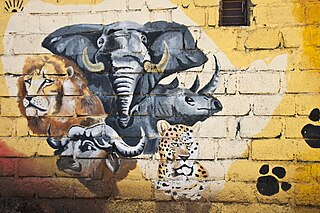
In Africa, the Big Five game animals are the lion, leopard, black rhinoceros, African bush elephant, and the African buffalo. The term was coined by big-game hunters, and refers to the five most difficult animals in Africa to hunt on foot, but is now also widely used by safari tour operators.
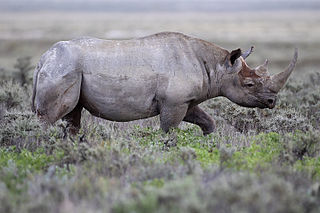
The black rhinoceros or hook-lipped rhinoceros is a species of rhinoceros, native to eastern and southern Africa including Angola, Botswana, Kenya, Malawi, Mozambique, Namibia, South Africa, Eswatini, Tanzania, Zambia, and Zimbabwe. Although the rhinoceros is referred to as black, its colours vary from brown to grey.
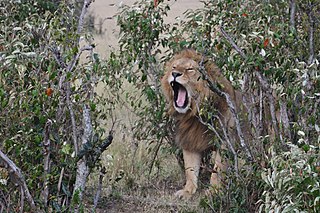
Nairobi National Park is a national park in Kenya that was established in 1946 about 7 km (4.3 mi) south of Nairobi. It is fenced on three sides, whereas the open southern boundary allows migrating wildlife to move between the park and the adjacent Kitengela plains. Herbivores gather in the park during the dry season. Nairobi National Park is negatively affected by increasing human and livestock populations, changing land use and poaching of wildlife. Despite its proximity to the city and its relative small size, it boasts a large and varied wildlife population, and is one of Kenya's most successful rhinoceros sanctuaries.

Etorphine (M99) is a semi-synthetic opioid possessing an analgesic potency approximately 1,000–3,000 times that of morphine. It was first prepared in 1960 from oripavine, which does not generally occur in opium poppy extract but rather the related plants Papaver orientale and Papaver bracteatum. It was later reproduced in 1963 by a research group at MacFarlan Smith in Gorgie, Edinburgh, led by Kenneth Bentley. It can also be produced from thebaine.
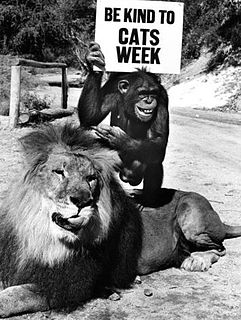
Daktari is an American family drama series that aired on CBS between 1966 and 1969. The series is an Ivan Tors Films Production in association with MGM Television starring Marshall Thompson as Dr. Marsh Tracy, a veterinarian at the fictional Wameru Study Center for Animal Behavior in East Africa.
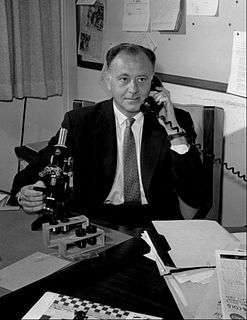
Ivan Tors was a Hungarian playwright, film director, screenwriter, and film and television producer with an emphasis on non-violent but exciting science fiction, underwater sequences, and stories involving animals. He started a Miami-based film studio now known as Greenwich Studios, and later a music company.
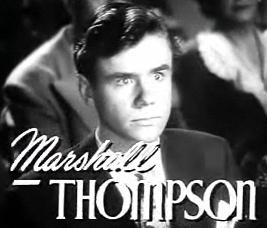
James Marshall Thompson was an American film and television actor.
Colin Albert Murdoch was a New Zealand pharmacist and veterinarian who made a number of significant inventions, in particular the tranquilliser gun, the disposable hypodermic syringe and the child-proof medicine container. He had a total of 46 patents registered in his name.

La Palmyre Zoo is a zoo in Les Mathes, Charente-Maritime, near Royan, in southwestern France. It was created in 1966 in the forest of la Coubre by Claude Caillé. Extending over 18 hectares, including 14 of landscape garden, it offers the visitor the opportunity of observing more than 1600 animals of all kinds, divided into 145 species, over a distance of more than 4 kilometres (2.5 mi).
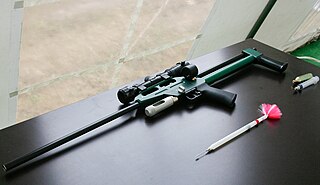
A tranquillizer gun, capture gun or dart gun, is a non-lethal air gun used to reduce irritability or agitation in animals via anesthetic drugs commonly referred to as tranquilizers. The gun shoots a dart tipped with a hypodermic needle and filled with a dose of tranquilizer solution that is either sedative, comatosing or paralytic. The gun makes it possible for wild animals to be sedated, while domestic animals are sedated in the same manner that humans are.
Robert Hermes, DVM, Ph.D.(born November 15, 1969 in Celle, Germany) is a veterinarian researcher at The Leibniz-Institute of Zoo and Wildlife Research in Berlin. He studied veterinary medicine at the Freie Universität Berlin. He completed a Ph.D. in reproductive management.
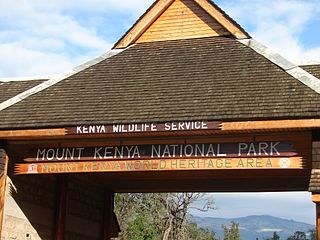
Kenya Wildlife Service is a State Corporation under the Ministry of Tourism and Wildlife established by an Act of Parliament; Wildlife Conservation and Management Act CAP 376, of 1989 now repealed and replaced by the Wildlife Conservation and Management Act, 2013. At independence, the Government of Kenya committed itself to conserving wildlife for posterity with all the means at its disposal, including the places animals lived, forests and water catchment areas.
Ralph Helfer is an American animal behaviorist, creator of Marine World/Africa USA, and author of books about animals.

Susanne Hart in South Africa), also known under the short form Sue Hart or as Susanne Harthoorn, was a South African veterinarian and environmentalist.
Cynthia Jane Moss is an American ethologist and conservationist, wildlife researcher, and writer. Her studies have concentrated on the demography, behavior, social organization, and population dynamics of the African elephants of Amboseli. She is the director of the Amboseli Elephant Research Project, and is the program director and trustee for the Amboseli Trust for Elephants (ATE).
Esmond Bradley Martin was an American conservationist who fought for both the preservation of elephants against the illegal ivory trade, and for the rhinoceros against the illegal trade of rhinoceros horns. A trained geographer, Martin was considered a world-renowned expert in the ivory trade and rhinoceros horn trade. He had been a special envoy of the United Nations for the conservation of rhinoceros. Militant for a reduction in the demand for ivory to dry up the market, he participated notably in the stop of rhinoceros horn trade to China in 1993 and ivory in 2017.

The Pian Upe Wildlife Reserve is a conservation area in the Karamoja subregion of northeastern Uganda. It is the second largest conservation protected area in Uganda.

The Sheldrick Wildlife Trust operates an orphan elephant rescue and wildlife rehabilitation program in Kenya. It was founded in 1977 by Dame Daphne Sheldrick to honor her late husband, David Sheldrick. Since 2001, it has been run by their daughter, Angela Sheldrick.

Angalifu was a captive northern white rhinoceros held at the San Diego Zoo Safari Park. At the time of his death, he was one of six living northern white rhinoceroses in the world, one of two living males in the world, and the only male on the American continents. He was outlived by male Sudan and females Najin and Fatu.













